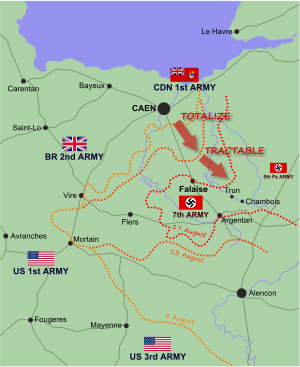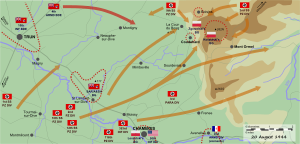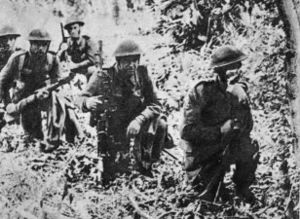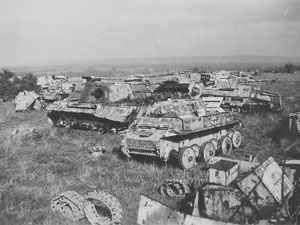Operation Tractable facts for kids
Quick facts for kids Operation Tractable |
|||||||
|---|---|---|---|---|---|---|---|
| Part of Operation Overlord | |||||||
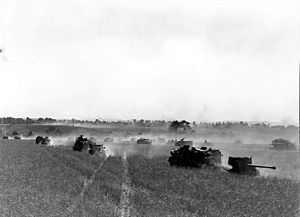 Canadian forces moving toward Falaise on 14 August 1944 |
|||||||
|
|||||||
| Belligerents | |||||||
| Commanders and leaders | |||||||
| Strength | |||||||
| 2 infantry divisions 2 armoured divisions 1 armoured brigade 1 tank brigade |
1 SS panzer division 2 infantry divisions |
||||||
| Casualties and losses | |||||||
| Canada: 5,500 casualties Poland: 325 killed 1,002 wounded 114 missing |
2,000 killed 5,000 captured 55 tanks destroyed 152 armoured vehicles destroyed 44 guns destroyed |
||||||
Operation Tractable was a big attack during World War II. It was the last major push by Canadian and Polish soldiers in the Battle of Normandy. British tanks also helped them. Their goal was to capture important French towns like Falaise, Trun, and Chambois.
The First Canadian Army led this mission. They worked with the 1st Polish Armoured Division and a British armoured group. They fought against the German Army Group B. This battle created the largest "pocket" or encirclement of enemy soldiers on the Western Front during the war.
The start was slow, and they didn't gain much ground at first. But then, the 1st Polish Armoured Division used clever new tactics. They pushed towards Chambois. By August 19, 1944, they had partly closed the "Falaise Pocket". This trapped about 150,000 German soldiers.
The gap in the pocket became very narrow, just a few hundred meters. Polish forces fought hard against German tanks on Hill 262 (Mont Ormel). The gap wasn't closed quickly enough, and thousands of German soldiers escaped on foot. The Polish soldiers, with help from artillery, fought for two days straight. They held off attacks from parts of seven German divisions. On August 21, Canadian soldiers arrived and helped the Polish survivors. They finally sealed the Falaise Pocket by meeting up with the Third US Army. This led to the surrender of the remaining German 7th Army units stuck in the pocket.
Why the Battle Happened
After the US 1st and 3rd Armies broke out from the Normandy beaches in July 1944, Adolf Hitler ordered a counter-attack. This was called Operation Lüttich. However, the Allies knew about this plan because they had secretly decoded German messages.
By August 7, Operation Lüttich had failed. Many German soldiers were now surrounded by the Allied forces. After this failure, the town of Falaise became a key target for the Allied forces. Capturing it would cut off almost all of the German Army Group B.
To do this, General Harry Crerar of the Canadian 1st Army and Lieutenant-General Guy Simonds planned Operation Totalize. This attack aimed to break through German defenses. Totalize used a special night attack with new armored vehicles called Kangaroo armoured personnel carriers. US bombers also supported the attack the next day.
Even with some early success, the Canadian attack slowed down. Strong German counterattacks caused many casualties for Canadian and Polish soldiers. By August 10, Canadian troops were near Falaise, but they needed another big attack to defeat the German defenses.
Getting Ready for Battle
New Battle Plans
Operation Tractable used lessons learned from the earlier Operation Totalize. They saw how effective armored infantry and heavy bomber planes were. Tractable was planned as a daytime attack. First, bombers would weaken German defenses. Then, the 4th Canadian (Armoured) Division would advance on one side. The 3rd Canadian Infantry Division would attack on the other, supported by the 2nd Canadian Armoured Brigade.
A huge smoke screen from Canadian artillery would protect their advance. Field Marshal Bernard Montgomery hoped Canadian forces would control Falaise by midnight on August 14. From there, all three groups would push towards Trun, about 18 kilometers (11 miles) east of Falaise. The 1st Polish Armoured Division, with about 10,000 men, would also help. Once in Trun, they could quickly meet the Third US Army at Chambois.
The main German defense on the road to Falaise was the 12th SS Panzer Division Hitlerjugend. This division also included what was left of two other German infantry divisions. German forces trapped in the Falaise Pocket were about 350,000 men. If the Allies had surprised them, they might have broken through quickly.
However, on the night of August 13/14, a Canadian officer got lost. He drove into German lines and was killed. The Germans found a copy of the attack plans on his body. Because of this, the 12th SS Panzer Division moved most of its remaining strength. They placed 500 soldiers, 15 tanks, and twelve powerful 8.8 cm anti-tank guns along the Allies' expected path.
The Battle Begins
Pushing for Falaise
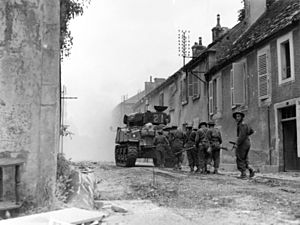
Operation Tractable started at noon on August 14. About 800 Avro Lancaster and Handley Page Halifax heavy bombers from the RAF Bomber Command attacked German positions. Like in Operation Totalize, many bombs fell short of their targets by mistake. This caused 400 casualties among Polish and Canadian soldiers.
Under a smoke screen laid by their artillery, two Canadian divisions moved forward. Even with reduced visibility, German units caused heavy losses for the Canadian 4th Armoured Division. This included their commander, Brigadier Leslie Booth. The division was moving south towards Falaise. Throughout the day, constant attacks by the Canadian 4th and Polish 1st Armoured Divisions forced a crossing of the Laison River. Limited access to crossing points over the Dives River allowed German counterattacks. The town of Potigny fell to Polish forces in the late afternoon.
By the end of the first day, parts of the Canadian 3rd and 4th Divisions reached Point 159, just north of Falaise. But they couldn't break into the town. To strengthen the attack, Simonds ordered the Canadian 2nd Infantry Division to move to the front. He hoped this would be enough to capture the town.
Progress on the first day was slower than expected. But Operation Tractable continued on August 15. Both armored divisions pushed southeast toward Falaise. The Canadian 2nd and 3rd Infantry Divisions, supported by the Canadian 2nd Armoured Brigade, kept driving south. After tough fighting, the 4th Armoured Division captured Soulangy. However, gains were small as strong German resistance stopped a breakthrough to Trun.
On August 16, the Canadian 2nd Infantry Division entered Falaise. They met only light resistance from German Waffen-SS units and scattered groups of infantry. It took two more days to clear all resistance in the town. But the first main goal of Operation Tractable was achieved. Simonds began to regroup his armored forces for a new push towards Trun. This was to close the Falaise Pocket.
Closing the Gap (August 16–19)
Pushing for Trun and Chambois
The push for Trun by Polish and Canadian Armoured Divisions began on August 16. They made early attacks to prepare for the main assault on Trun and Chambois. On August 17, both armored divisions of the Canadian 1st Army advanced. By early afternoon, the Polish 1st Armoured Division had outflanked the 12th SS Panzer Division. This allowed several Polish groups to reach their goals and expand their position northwest of Trun.
Stanisław Maczek, the Polish commander, split his forces into three battle groups. Each had an armored regiment and an infantry battalion. One group attacked southwest, cutting off Trun. It took control of the high ground overlooking the town and the Dives river valley. This allowed a strong attack by the Canadian 4th Armoured Division on Trun. The town was freed on the morning of August 18.
As Canadian and Polish forces freed Trun, Maczek's second armored battle group moved southeast. They captured Champeaux and prepared for future attacks on Chambois. The front was now only about 6 kilometers (4 miles) from the US V Corps in Chambois. By the evening of August 18, all of Maczek's battle groups were just north of Chambois. With more soldiers quickly arriving from the 4th Canadian Armoured Division, Maczek was in a great position to close the gap the next day. The presence of the Polish Armoured Division also warned German Field Marshal Walther Model that he needed to keep the pocket open.
Sealing the Pocket
Early on August 19, Lieutenant General Simonds met with his commanders. They finalized plans for closing the gap. The 4th Armoured Division would attack Chambois. Two Polish battle groups would cover their advance. Two more Polish battle groups would attack eastward, securing Hill 262. This would protect the eastern sides of the main attack.
The 2nd and 3rd Infantry Divisions would continue their tough attacks. They would push against the northern edges of the Falaise Pocket. This caused heavy losses for the tired 12th SS Panzer Division. The attack started almost immediately after the meeting. One Polish battle group advanced toward Chambois. The "Currie Task Force" of the 4th Armoured Division covered their advance.
At the same time, two Polish battle groups moved towards Hill 262. Despite strong German resistance, Battlegroup Zgorzelski secured Point 137, west of Hill 262. By early afternoon, Battlegroup Stefanowicz captured the hill. They destroyed a German infantry company in the process. As a result of this fighting, Polish casualties made up almost half of all losses for the Canadian 1st Army.
By late afternoon on August 19, Canadian and Polish forces met up with the US 80th Division and 90th Division already in Chambois. The Falaise Gap was closed, trapping Model's forces. As they linked up, the German II SS Panzer Corps began its counterattack. They attacked Polish forces on Hill 262 to try and reopen the pocket. With American and Canadian forces also facing German counterattacks, the Polish forces had to defend against two experienced German tank divisions to keep the gap closed.
The Fight Continues (August 20)
St. Lambert-sur-Dives and Hill 117
On the morning of August 20, two German groups, the 2nd and 9th SS Panzer Divisions, attacked Polish positions on Hill 262. At the same time, the 16th Infantry and 12th SS Panzer Divisions attacked American and Canadian forces from inside the pocket. They managed to open small paths through Allied lines.
By mid-morning, 2,000 survivors of the German 2nd Parachute Division broke through Canadian positions. This happened along the Dives River and at Point 117. Around noon, several units of the 10th SS, 12th SS, and 116th Panzer Divisions broke through these weakened spots.
By mid-afternoon, reinforcements arrived. An armored group led by Major David Vivian Currie reached St. Lambert-sur-Dives. This stopped two German armies from escaping the pocket. For the next 36 hours, Currie's group fought off almost constant German attacks. They destroyed seven German tanks, twelve 88 mm anti-tank guns, and 40 other vehicles. In the fierce fighting around St. Lambert-sur-Dives, Currie's group caused nearly 2,000 casualties for the attacking Germans. This included 300 killed and 1,100 captured.
By the evening of August 20, the Germans had stopped their attacks on St. Lambert-sur-Dives. The remaining members of the 84th Corps surrendered to Canadian and American forces near Chambois. For his brave actions at St. Lambert-sur-Dives, Major Currie received the Victoria Cross. He was the only Canadian to get this high honor during the Normandy Campaign.
Hill 262 (Mont Ormel)
While Currie's force held off Germans at St. Lambert, two Polish battle groups fought a long battle. They faced two well-trained German SS Panzer divisions on Hill 262. Throughout the night of August 19, Polish forces dug in around Hill 262. Southwest of Mont Ormel, German units moved along what became known as "The Corridor of Death." The Polish soldiers caused heavy losses with well-aimed artillery fire. Polish infantry and tanks were supported by Canadian artillery. Captain Pierre Sévigny, an artillery observer, was crucial in defending Hill 262. He later received Poland's highest military award for his efforts.
From the northeast, the 2nd SS Panzer Division planned a strong attack. They aimed for the four infantry battalions and two armored regiments of the Polish 1st Armoured Division dug in on Hill 262. The 9th SS Panzer Division would attack from the north. At the same time, it would stop Canadian units from helping the Polish division. Having broken out of the Falaise Pocket, the 10th SS, 12th SS, and 116th Panzer Divisions would then attack Hill 262 from the southwest. If they could clear this big obstacle, German units could fully retreat from the Falaise Pocket.
The first attack on Polish positions came from the "Der Führer" Regiment of the 2nd SS Panzer Division. The Polish Podhale Rifles battalion pushed them back. But they used up a lot of their ammunition doing so. The second attack was very damaging to the Polish armored forces. A single German tank, positioned on Point 239, destroyed five Sherman tanks in just two minutes. At this time, the 3rd Parachute Division, with an armored regiment, attacked Mont Ormel from inside the Falaise Pocket. This attack was stopped by artillery, which "massacred" German soldiers and tanks.
As the attack from the southwest weakened, the 2nd SS Panzer Division restarted its attack on the northeast of the ridge. Polish units were now focused on the southern edges of their position. The 2nd SS was able to force a path through to the 3rd Parachute Division by noon. This opened a corridor out of the pocket. By mid-afternoon, almost 10,000 German troops had escaped through this path.
Despite being overwhelmed by strong counterattacks, Polish forces held the high ground on Mont Ormel. They called it "The Mace" (Maczuga). They caused many casualties for German forces escaping through the gap with artillery fire. Annoyed by these units, German General Paul Hausser ordered the Polish positions to be "eliminated." Although strong forces attacked, including the 352nd Infantry Division and parts of the 2nd SS Panzer Division, the counterattack failed. The battle had used up almost all of the Poles' ammunition, leaving them in a dangerous spot.
At 7:00 PM on August 20, a 20-minute ceasefire was arranged. This allowed German forces to evacuate a large group of medical vehicles. Immediately after these vehicles passed, the fighting started again and became even more intense. The Germans could not remove the Polish forces. But the defenders were completely exhausted. With little ammunition left, the Poles had to watch as the remaining German forces escaped from the pocket. Despite this, Polish artillery kept firing on every German unit that entered the escape corridor. Stefanowicz, the commander of the Polish battle groups on Hill 262, doubted his force's chances of survival:
"Gentlemen. Everything is lost. I do not believe [the] Canadians will manage to help us. We have only 110 men left, with 50 rounds per gun and 5 rounds per tank... Fight to the end! To surrender to the SS is senseless, you know it well. Gentlemen! Good luck—tonight, we will die for Poland and civilization. We will fight to the last platoon, to the last tank, then to the last man."
The Final Push (August 21)
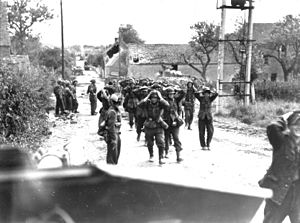
Night brought some relief to the German and Polish forces around Mont Ormel. Fighting was scattered, as both sides avoided contact. Frequent Polish artillery barrages stopped German attempts to retreat. In the morning, German attacks on the position started again. Though not as organized as the day before, the attack still reached the last Polish defenders on Mont Ormel. As the remaining Polish forces fought off the attack, their tanks had to use their very last ammunition.
Around noon, the last SS remnants launched a final assault. They attacked the positions of the 9th Battalion. Polish forces defeated them at very close range. There would be no more attacks. The two Polish battle groups had survived the fierce attack. They had been surrounded by German forces for three days. Within an hour, The Canadian Grenadier Guards met up with what was left of Stefanowicz's men. By late afternoon, the rest of the 2nd and 9th SS Panzer Divisions began their retreat to the Seine River. The Falaise Gap was permanently closed. A large number of German forces were still trapped inside the pocket.
What Happened Next
Counting the Costs
It's hard to know the exact Canadian casualties for Operation Tractable. This is because it followed other battles in early August. Losses during Operation Totalize and Tractable together are about 5,500 men. German casualties during Operation Tractable are also unclear. We have rough numbers for the entire Falaise Pocket, but not just for Tractable.
After the Falaise Pocket, the German 7th Army was severely weakened. They lost between 50,000 and 200,000 men. They also lost over 200 tanks, 1,000 guns, and 5,000 other vehicles. In the fighting around Hill 262, the Germans lost 2,000 men killed and 5,000 taken prisoner. They also lost 55 tanks, 152 other armored vehicles, and 44 guns. Polish casualties for Operation Tractable (up to August 22) were 1,441 men. This included 325 killed, 1,002 wounded, and 114 missing.
Honoring the Fighters
In the British and Commonwealth system of battle honours, taking part in Operation Tractable was recognized. This was included as part of the "Falaise" honor for service from August 7 to 22. Specific honors were given in 1957, 1958, and 1959. These included "Laison" (or "The Laison" for Canadian units) for service from August 14 to 17. "Chambois" was for August 18 to 22, and "St Lambert-sur-Dives" for August 19 to 22.


